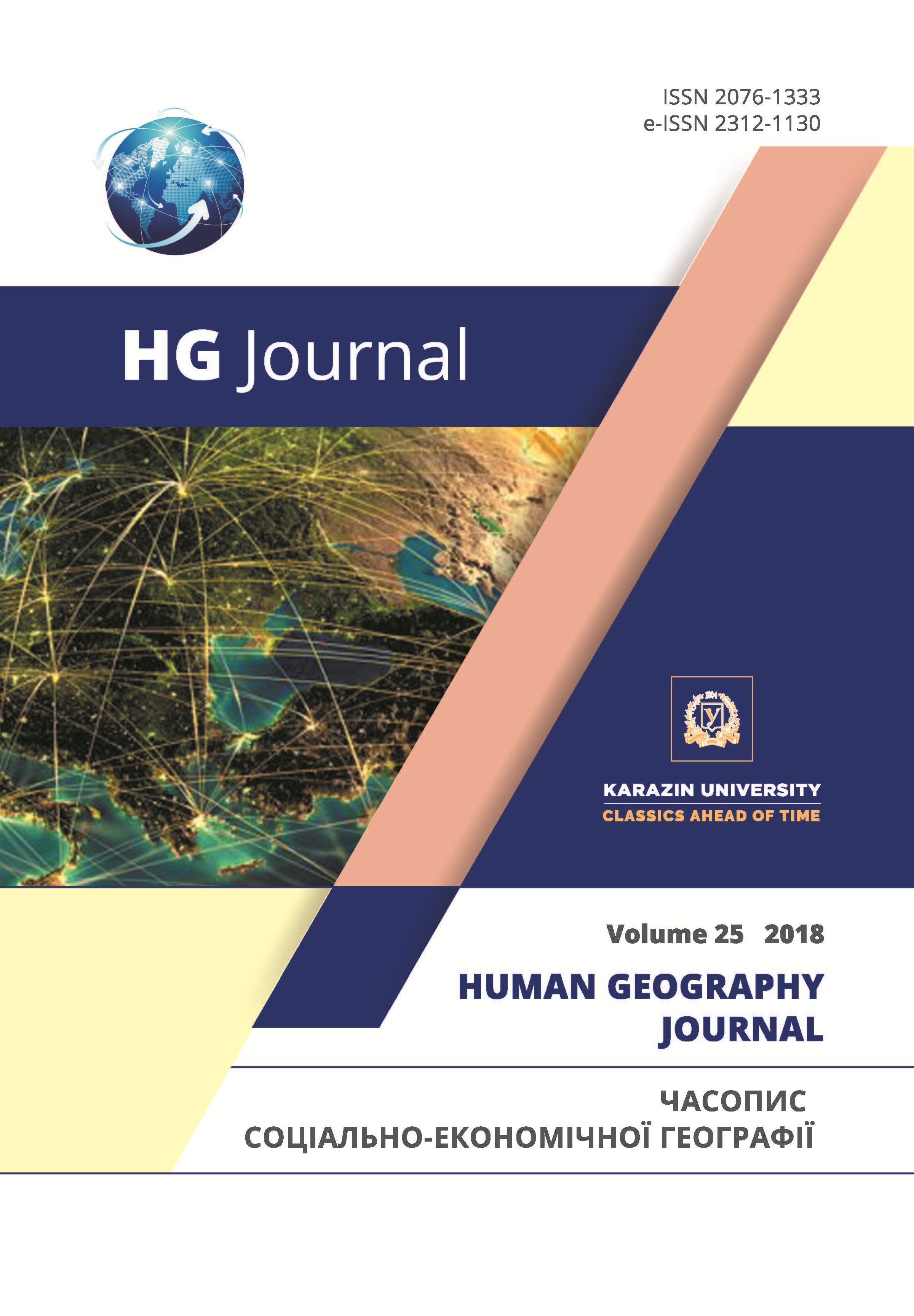Моделювання траєкторій розвитку у багатовимірному просторі: суспільно-географічна інтерпретація
Анотація
У статті описано моделювання траєкторії розвитку у багатовимірному ознаковому простору для аналізу складових суспільно-географічного процесу. Висвітлено методологічні основи моделювання траєкторії розвитку соціогеосистеми у багатовимірному просторі. У відповідності до географічного, системного і синергетичного підходів суспільно-географічні процеси описуються сотнями параметрів. Адекватна і коректна математична обробка такого фактичного матеріалу можлива з використанням нормованого багатовимірного ознакового простору, де пропонується математична модель реальної траєкторії розвитку об’єкту або процесу. Наведено основні параметри оцінки, зокрема головна діагональ у гіперкубі багатовимірного простору розглядається як еталон оптимального розвитку. Порівняння реальної траєкторії з оптимальною, визначення проекції вектору розвитку на оптимальну траєкторію, відхилення від оптимальної траєкторії містять інформацію про особливості перебігу процесу. Запропонований метод було застосовано для моделювання траєкторій геодемографічного розвитку в розрізі районів Харківської області за період 2002-2015 рр. на основі 72 вихідних статистичних параметрів для демонстрації його особливостей на результатах конкретних досліджень. Виконано групування районів області, показано часові особливості, встановлено фази прогресивного та регресивного демографічного розвитку за досліджуваний період з урахуванням значної кількості вихідних даних. Моделювання траєкторії розвитку дозволяє визначити чітку перспективу, моделювати та прогнозувати подальший розвиток, планувати темпи розвитку, є зручним інструментом моніторингу та дозволяє розробляти науково-обґрунтовані заходи з управління тощо.
Завантаження
Посилання
Zinovev, A., Polunin, Yu. (2008). Analiz dinamicheskikh dannykh «Politicheskogo Atlasa Sovremennosti»: evolyutsiya gosudarstva kak mnogomernaya trayektoriya [Analysis of the dynamic data of the “Political Atlas of Modernity”: the evolution of the state as a multidimensional trajectory] [in Russian].
Niemets, L.M., Sehidа, K.Yu. (2017). Innovatsiyno-investitsiyniy potentsial yak osnova konkurentospromozhnosti regionu (na prykladi Kharkivskoi oblasti) [The innovative-investment potential as the regional competitiveness base (a case study of Kharkiv region)]. Kolektyvna monografiya / za zag. red. Kharkiv: KhNU imeni V.N. Karazina, 520 [in Ukrainian]
Niеmets, K.A., Sehida, K.Yu, Niеmets, L.M. (2016). Bahatovymirnyi analiz u suspilniy geografii (netraditsiyni metody) [Multidimensional analysis in social geography (non-traditional methods)]. Monografiya, Kharkiv: KhNU smeni V.N. Karazina, 120 [in Ukrainian].
Niemets, K.A., Sehida, K.Yu, Niemets, L.M. Klyuchko, L.V. (2015). Kontseptsiya bahatovymirnoho prostoru v suchasniy suspilniy geografii [The concept of multidimensional space in modern social geography]. Materialy vseukrayinskoi naukovoi konferentsii «Lvivska suspilno-geografichna shkola». Lvivskyi natsionalnyi universitet imeni Ivana Franka, 116-126 [in Ukrainian].
Niemets, K.A. (2009). Modelyuvannya traуktorii rozvytku regionalnykh sotsiogeosystem Ukrainy. [Modeling of the trajectory of development of regional sociogeosystems of Ukraine]. Chasopys sotsialno-ekonomichnoi geografii. Kharkiv, KhNU imeni V.N. Karazina, 7(2), 66-80 [in Ukrainian].
Niemets, L., Sehida, K., Kobylin, P. (2014). Analiz trayektorii rozvytku sotsialnoi infrastruktury Kharkivskoi ob-lasti [Analysis of the trajectory of social infrastructure development in the Kharkiv region]. Aktualni problemy eko-nomiky. Kyiv, 11(161), 409-419 [in Ukrainian].
Ofitsiynyi sayt Holovnoho upravlinnya statystyky v Kharkivskiy oblasti [Office site of the Department of Statis-tics in the Kharkov region]. Retrieved from http://www.kh.ukrstat.gov.ua [in Ukrainian].
Sehida, K.Yu. (2017). Suspilno-geografichna kontseptsiya geodemografichnoi systemy regionu. [Social geo-graphic concept of the regional geodemographic system]. Doctor’s thesis. Kyiv, KNU [in Ukrainian].
Nagin, D.S., Jones, B.L., Passos, V.L., Tremblay, R.E. (2016). Group-based multi-trajectory modeling – Statistical Methods in Medical Research 0(0) 1-9.
Bauer, D.J., Reyes, H.L. McNaughton. (2010). Modeling Variability in Individual Development: Differences of Degree or Kind? 4(2), 114-122.
Nagin, D.S. (2005). Group-based Modeling of Development. Cambridge, MA.: Harvard University Press.
Niemets, L., Sehida, K., Husieva, N. (2015). Demographic potential as the basis for social and economic devel-opment. Economic Annals-XXI, 3-4(1), 93-96. Retrieved from http://soskin.info/userfiles/file/2015/3-4_1_2015/Niemets,%20Segida,%20Guseva.pdf.
Wesley, G. (2016). Jennings and Caitlyn Meade. Group-Based Trajectory Modeling. Criminology and Criminal Justice, Criminological Theories.
Kreuter, F., Muthén, B. (2007). Running head: Bridging multilevel and group-based approaches. Journal of Quan-titative Criminology, 21.
Stamps, J.A., Frankenhuis, W.E. (2016). Bayesian Models of Development. Trends in Ecology & Evolution, 31(4), 260-268.
Авторське право (c) 2018 Kostyantyn Niemets, Kateryna Sehida, Lyudmyla Niemets, Ievgeniia Telebienieva, Kateryna Kravchenko

Цю роботу ліцензовано за Міжнародня ліцензія Creative Commons Attribution 4.0.




